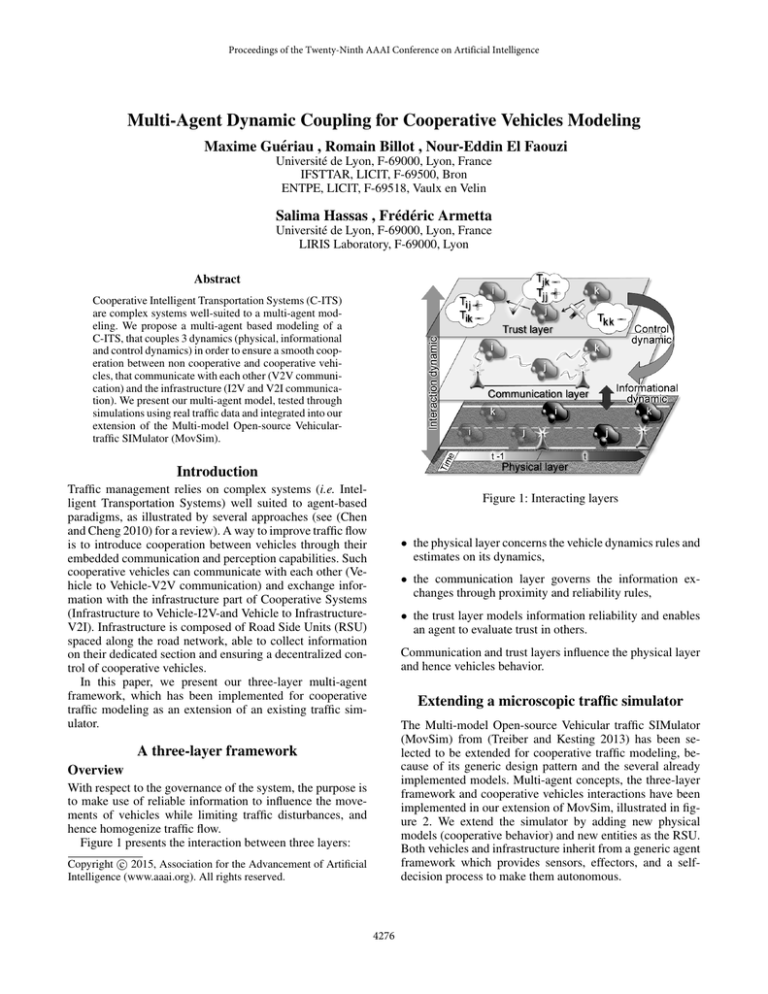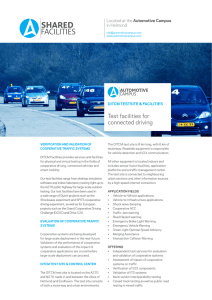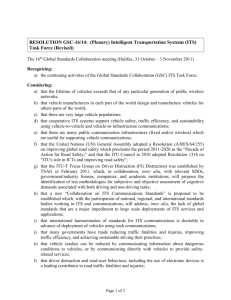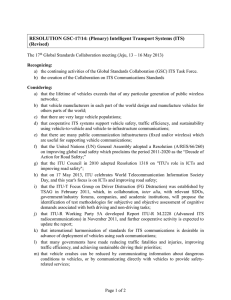
Proceedings of the Twenty-Ninth AAAI Conference on Artificial Intelligence
Multi-Agent Dynamic Coupling for Cooperative Vehicles Modeling
Maxime Guériau , Romain Billot , Nour-Eddin El Faouzi
Université de Lyon, F-69000, Lyon, France
IFSTTAR, LICIT, F-69500, Bron
ENTPE, LICIT, F-69518, Vaulx en Velin
Salima Hassas , Frédéric Armetta
Université de Lyon, F-69000, Lyon, France
LIRIS Laboratory, F-69000, Lyon
Abstract
Cooperative Intelligent Transportation Systems (C-ITS)
are complex systems well-suited to a multi-agent modeling. We propose a multi-agent based modeling of a
C-ITS, that couples 3 dynamics (physical, informational
and control dynamics) in order to ensure a smooth cooperation between non cooperative and cooperative vehicles, that communicate with each other (V2V communication) and the infrastructure (I2V and V2I communication). We present our multi-agent model, tested through
simulations using real traffic data and integrated into our
extension of the Multi-model Open-source Vehiculartraffic SIMulator (MovSim).
Introduction
Traffic management relies on complex systems (i.e. Intelligent Transportation Systems) well suited to agent-based
paradigms, as illustrated by several approaches (see (Chen
and Cheng 2010) for a review). A way to improve traffic flow
is to introduce cooperation between vehicles through their
embedded communication and perception capabilities. Such
cooperative vehicles can communicate with each other (Vehicle to Vehicle-V2V communication) and exchange information with the infrastructure part of Cooperative Systems
(Infrastructure to Vehicle-I2V-and Vehicle to InfrastructureV2I). Infrastructure is composed of Road Side Units (RSU)
spaced along the road network, able to collect information
on their dedicated section and ensuring a decentralized control of cooperative vehicles.
In this paper, we present our three-layer multi-agent
framework, which has been implemented for cooperative
traffic modeling as an extension of an existing traffic simulator.
Figure 1: Interacting layers
• the physical layer concerns the vehicle dynamics rules and
estimates on its dynamics,
• the communication layer governs the information exchanges through proximity and reliability rules,
• the trust layer models information reliability and enables
an agent to evaluate trust in others.
Communication and trust layers influence the physical layer
and hence vehicles behavior.
Extending a microscopic traffic simulator
The Multi-model Open-source Vehicular traffic SIMulator
(MovSim) from (Treiber and Kesting 2013) has been selected to be extended for cooperative traffic modeling, because of its generic design pattern and the several already
implemented models. Multi-agent concepts, the three-layer
framework and cooperative vehicles interactions have been
implemented in our extension of MovSim, illustrated in figure 2. We extend the simulator by adding new physical
models (cooperative behavior) and new entities as the RSU.
Both vehicles and infrastructure inherit from a generic agent
framework which provides sensors, effectors, and a selfdecision process to make them autonomous.
A three-layer framework
Overview
With respect to the governance of the system, the purpose is
to make use of reliable information to influence the movements of vehicles while limiting traffic disturbances, and
hence homogenize traffic flow.
Figure 1 presents the interaction between three layers:
c 2015, Association for the Advancement of Artificial
Copyright Intelligence (www.aaai.org). All rights reserved.
4276
Introducing cooperation
A way to introduce cooperation at a microscopic level is to
derive a multi-anticipative car following model able to describe vehicle to vehicle (V2V) communication and to improve traffic stability (Ge, Dai, and Dong 2006). We define the bilateral multi-anticipation law as a combination of
weighted influences from surrounding vehicles (see (Monteil et al. 2014b) for more details). Cooperative vehicles can
then take advantage of all the perceived data (from sensors,
communication) to construct an extended perception by considering more than one vehicle ahead (anticipation) and behind (bilateral). All model parameters are randomly picked
from a calibrated set (Monteil et al. 2014a) to reproduce
drivers variability.
Figure 2: Screenshot of the cooperative traffic view in our
extended version of MovSim simulator
Developing Sensor-oriented perception
Cooperative vehicles interact with their environment at the
physical level. Each vehicle is designed as an autonomous
system able to sense its surrounding environment thanks to
embedded sensors, and then make a decision from this perception which is finally translated into a physical interaction (here, a longitudinal behavior i.e. an acceleration). Cooperative vehicles are equipped with a localization device
(for instance GPS receiver) and a front laser infrared telemeter (which senses relative distance and speed to immediate
leader); this information is completed by communication.
Non-cooperative vehicles perception is limited to their immediate leader (relative distance/speed) and they do not have
the ability to communicate.
Conclusion and future work
We have proposed a multi-agent based extension of an existing simulator to model complex interactions between cooperative vehicles and, potentially, to and from the infrastructure. The implemented framework models both communications (information dynamics) and physical interactions. The
additional control using the concept of trust improves the
robustness of the model against perturbations introduced by
sensors unreliability. The next step is to test different traffic
management actions and we plan to develop learning strategies for both RSU and cooperative vehicles thanks to trust
concepts.
Adding communication capabilities
References
As autonomous agents, cooperative vehicles can send and
receive information. We define three types of exchanged information embedded in dedicated messages:
• Measurement message: holds all the sensors values shared
by a vehicle to surrounding ones (broadcasting);
• Trust message: keeps the witness information concerning
the trust an agent has in another one;
• Speed recommendation message: holds the speed recommendation broadcasted by RSU to the vehicles according
to perceived aggregated traffic conditions.
All information embedded in messages helps the cooperative vehicles to extend their perception during their autonomous decision process. The communication layer design allows to implement other messages which are handled
during the agents self-decision process.
Castelfranchi, C., and Falcone, R. 1998. Principles of trust
for mas: cognitive anatomy, social importance, and quantification. In Proceedings of the International Conference on
Multi Agent Systems, 72–79.
Chen, B., and Cheng, H. H. 2010. A review of the applications of agent technology in traffic and transportation
systems. IEEE Transactions on Intelligent Transportation
Systems 11(2):485–497.
Ge, H. X.; Dai, S. Q.; and Dong, L. Y. 2006. An extended
car-following model based on intelligent transportation system application. Physica A: Statistical Mechanics and its
Applications 365(2):543–548.
Monteil, J.; Billot, R.; Sau, J.; Buisson, C.; and El Faouzi,
N.-E. 2014a. Calibration, estimation and sampling issues of
car following model. Proceedings of the 92rd annual meeting of the Transportation Research Board. T.
Monteil, J.; Billot, R.; Sau, J.; and El Faouzi, N.-E. 2014b.
Linear and weakly nonlinear stability analyses of cooperative car-following models. IEEE Transactions on Intelligent
Transportation Systems pp(99):1–13.
Schillo, M.; Funk, P.; Stadtwald, I.; and Rovatsos, M. 2000.
Using trust for detecting deceitful agents in artificial societies. Applied Artificial Intelligence Journal Special Issue
on Trust, Deception and Fraud in Agent Societies.
Treiber, M., and Kesting, A. 2013. Traffic flow dynamics:
data, models and simulation. Springer.
Implementing self-decision
The notion of trust is related to the concept of delegation,
which is critical in Multi-Agent Systems (Castelfranchi and
Falcone 1998). Cooperative traffic is a perfect example of
a delegation-based system since the action of a vehicle directly relies on the actions of other vehicles. According to
the designed three layers, cooperative vehicles can evaluate sensor reliability by comparing redundant information.
Then, a TrustNet (Schillo et al. 2000) local data structure
enables the agents to keep trust information from direct
and indirect sources in order to weight the information they
received. Other computational trust models can be implemented within the trust layer.
4277








